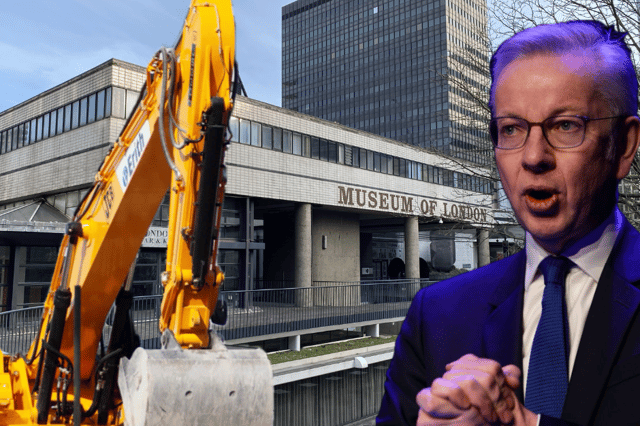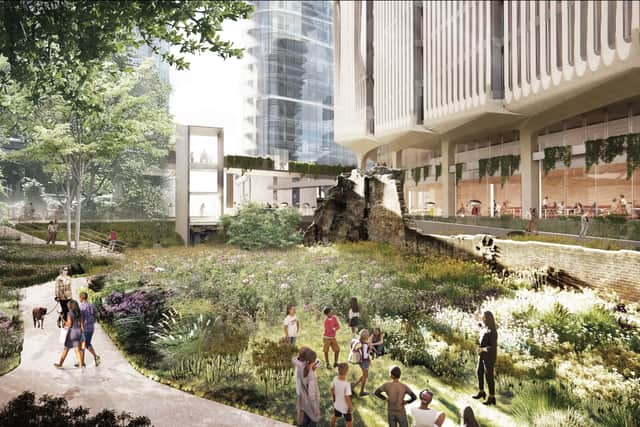Will Michael Gove bulldoze the former Museum of London?
and live on Freeview channel 276
Plans to demolish two historic buildings on the edge of the Barbican estate have been indicatively approved by the City of London Corporation – although a dramatic turn of events on Tuesday evening (April 16) prevented members granting full permission.
Less than a day before the City was expected to give the London Wall West development scheme the green light, the Department for Levelling Up, Housing and Communities (DLUHC) issued a last-minute ‘holding directive’, meaning the Corporation could consider and even refuse the application, but was unable to give it final approval.
Advertisement
Hide AdAdvertisement
Hide AdThe Government’s move leaves it open to Housing Secretary Michael Gove potentially becoming the ultimate authority on the proposal, which would involve knocking down the former Museum of London and Bastion House, if he chooses to call the decision in.
Speaking at Wednesday’s planning applications sub-committee meeting, Estelle Dehon KC, representing the Barbican Quarter Action (BQA) campaign group opposing the proposals, described the City’s plans as “a climate-reckless, office-led overdevelopment more than tripling the square meterage of offices in the north of the City, an area where the local plan does not envisage such distribution”.
“This is not just an environmental harm,” she said. “It is a harm to people, an economic harm from the high cost of climate impact and reputational harm.”
The proposals are to demolish the two buildings, including the former museum, which closed in December 2022 in preparation for a move to Smithfield Market. They would be replaced with office blocks ranging from five to 17 storeys, with retail, cultural and public realm improvements planned.
Advertisement
Hide AdAdvertisement
Hide AdThe plans have been met with fierce opposition since they were unveiled. Almost 900 objections were filed online, articulating concerns ranging from the expected carbon emissions to the impact on the heritage of the area. The City’s proclaimed “retrofit-first” policy has also been criticised, with some querying why the current buildings could not be repurposed and reused.
A spokesperson for the Corporation previously told the Local Democracy Reporting Service (LDRS) its Whole life Carbon (WLC) assessment indicated less carbon would be generated by redeveloping the site instead of retrofitting.
The City had indicated it would recommend the plans be approved in a letter sent to “contributors” in early April, despite the latest round of consultation not yet being completed.


Advertisement
Hide AdAdvertisement
Hide AdAt Wednesday’s meeting, officers reiterated carbon emissions are expected to be less for redevelopment than if the buildings were refurbished over a period of 60 years plus, with other benefits of the scheme including an increase in public space and biodiversity. The additional office space would contribute to the City’s projected need for 1.2 million more square metres of such floorspace by 2040. The issue of the carbon emissions associated with the demolition and construction of the site came up on numerous occasions, in part due to the City’s own net-zero and retrofit-first policies. Deputy Elizabeth King, who is not on the committee but spoke with the objectors, said: “If we want to be a leader in climate action and sustainability then we have very real alternatives. And they have failed to be presented here today.”
Members raised concerns from the proposal’s heritage impact, as indicated in submissions from groups such as Historic England and The Twentieth Century Society, to how it aligns with policies regarding tall buildings.
Alderwoman Sue Pearson noted current policies do not permit tall buildings in the area unless conditions are met. Ben Gilmartin, Partner at architectural firm Diller Scofidio + Renfro, said the height of the proposed buildings had been carefully studied, with the “new Bastion House” to be as tall as the current structure, and that their placement is intended to improve the openness across the site.
Common Councillor Steve Goodman aired doubts about how likely the scheme would remain as detailed in planning documents, with large-scale changes expected once a development partner has been found.
Advertisement
Hide AdAdvertisement
Hide Ad

The extent to which the opposition could be considered reasonable, given the nature of the City, was put to objectors by Deputy Brian Mooney. Asking them to reflect on whether they are opposing the scheme “because they do not and cannot accept we are living and working in a cheek by jowl and rather crowded environment”, Deputy Mooney added: “I hear lots of complaints and concerns about the 60-year construction. Well, we would have built nothing in the City post-war had we not had long and lengthy construction periods which we somehow managed to live with. I also very much hear a lot of people’s concerns about views. Of course, again, we’re not living in rural Dorset, we are living in a society and an environment where we don’t have a right to views, we know that.”
Later in the session, while the committee was still hearing questions put to officers by members, Deputy Mooney attempted to propose a motion to bypass the remaining queries and debate and go straight to a vote. “We’ve heard all morning from the developers, the opponents, and our officers. We’ve had ample opportunity to ask them a series of searching questions,” he said.
Deputy Marianne Fredericks warned skipping ahead would be “an incredibly dangerous thing to do given the position that we’re in. This is our site, the City of London’s application, and we are the City of London planning [committee], and we have a duty to ensure that every member has the ability to ask questions of officers.”
Committee chair Deputy Shravan Joshi chose to allow the outstanding questions, though agreeing to permit the motion to be voted on before the debate. Seconded by Deputy Henry Pollard, Deputy Mooney’s motion was agreed by 15 members, with nine against and one abstention. A vote on whether to approve the scheme in principle was subsequently held, with 16 in-favour and eight opposing, and again a single abstention.
Advertisement
Hide AdAdvertisement
Hide AdFollowing the meeting, a spokesperson for BQA said the group is “obviously disappointed” at the decision, but not surprised “given that this came from a local authority whose officials restated at today’s meeting that the City of London does not recognise the climate emergency”.
They added: “The chair of the committee chose to close down the debate so members were not allowed to discuss the application amongst themselves. A number of members requested that numerous conditions should be properly applied to the application to safeguard residents, heritage and the townscape, but these requests were rejected and will be agreed separately with the developer if the developer chooses to accept them. We hope that the secretary of state will now move to call this application in. The City is both applicant and the local planning authority and as such this complex and contested scheme must be subject to the highest levels of scrutiny.”
Deputy Joshi said: “Today’s resolution to grant permission for the London Wall West proposals brings us closer to our goal of meeting demand for 1.2 million square metres of new office space by 2040, a figure backed by industry experts taking into account projected jobs growth and new working from home patterns. The City of London is a global economic powerhouse, and it is vital we continue to signal to investors that we are keeping it that way, by delivering a centre of collaboration and innovation for the hundreds of thousands of people who work here.”
Mr Gove will now decide whether to call in the decision. If not, it is understood the indicative approval will carry through as final permission.
Comment Guidelines
National World encourages reader discussion on our stories. User feedback, insights and back-and-forth exchanges add a rich layer of context to reporting. Please review our Community Guidelines before commenting.
